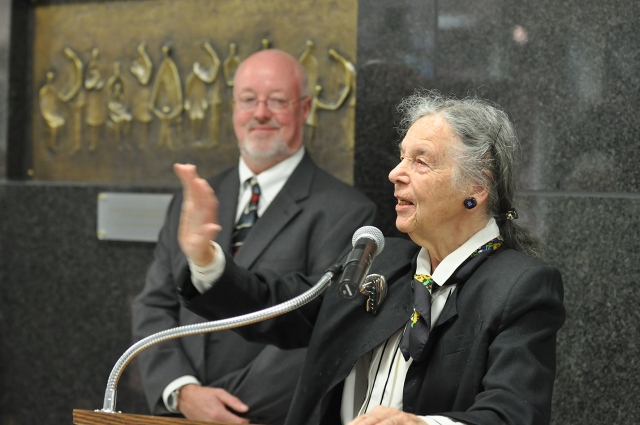A sculptor shares her life history

Dorothy Riester speaks at the 45th anniversary of the opening of Upstate University Hospital as hospital CEO John McCabe, MD, listens. In the background is her bronze commemorative plaque, which was reinstalled in the hospital lobby in 2010. (PHOTO BY WILLIAM MUELLER, NOV. 23, 2010).
On the back wall of Upstate University Hospital's lobby is a bronze plaque memorializing the Syracuse Dispensary. It was created in 1964 by the artist Dorothy Riester.
As she neared her 99th birthday last fall, Riester published an enlightening and enjoyable book of her life called “The Art of a Life, a Memoir," by Dorothy Riester as told to Victoria Kennedy.

Riester's book is $25 plus shipping at stonequarryhillartpark.org or by mail at PO Box 251, Cazenovia, NY 13035. Proceeds go to the Stone Quarry Hill Art Park.
Riester was born in Pittsburgh on Thanksgiving in 1916. She was the product of a happy marriage and had a sister named Bet. Her father instilled in her a love of nature, taking her on long rambles and encouraging her sense of freedom: "I was adventurous and impulsive all my life,” she writes. Her mother may be responsible for her love of flowers and floral design.
Riester began art lessons at age 12, "as a physical way to feel experience." Before attending Carnegie Institute of Technology (now known as Carnegie Mellon University), she went to the College of William and Mary. She remembers hearing novelist Gertrude Stein say, "When you know what you want to do, just do it."
She studied ceramics at the University of Pittsburgh and was apprenticed to a wood-carver, but mostly Riester developed her own talents. She met the man who would become her husband in the detention room in high school in the 10th grade, and her book relates their wonderful love story. Bob Riester was an inventor, a silent type, pipe in hand or mouth at all times -- and supportive of her art. They married in 1939.
While at Carnegie, where she later taught design and art, Riester and her husband bought an old farmhouse/barn with no heat, light or water. They restored the structure and built an art studio. At that time sculpture was primarily the reproduction of the human form in clay or bronze. Riester introduced the use of steel and abstract art, requiring heavy machinery and welding, to Carnegie.
When the Riesters moved to Syracuse, where she received a master's degree and taught art at Syracuse University, they bought a house on Townsend Street and restored it as a home and studio. Later they designed and built, with some help, their home on Stone Quarry Road in Cazenovia. It began as a summer home, in 1958. They expanded it and moved there year-round in 1965.
In 1991 they incorporated the 104-acre Stone Quarry Hill Art Park as a not-for-profit, "a place where artist and nature could interact," and where Riester was truly an artist in residence.
Twenty years later, National Geographic listed the Art Park No. 2 among sculpture parks and trails in “Secret Journeys of a Lifetime, 500 of the World‘s Best Hidden Travel Gems.” The home and studio were placed on the National Register of Historic Places in 2014.
For those of us getting up in years and for younger people with visions and hopes for a future long life, this book is an inspiration. It includes many photos of Dorothy throughout her life as well as photos of her art and sculptures.
Joel Potash, MD, is an emeritus professor at Upstate‘s Center for Bioethics and Humanities and a member of the Board of Directors of Stone Quarry Hill Art Park.
This article appears in the spring 2016 issue of Upstate Health magazine.


